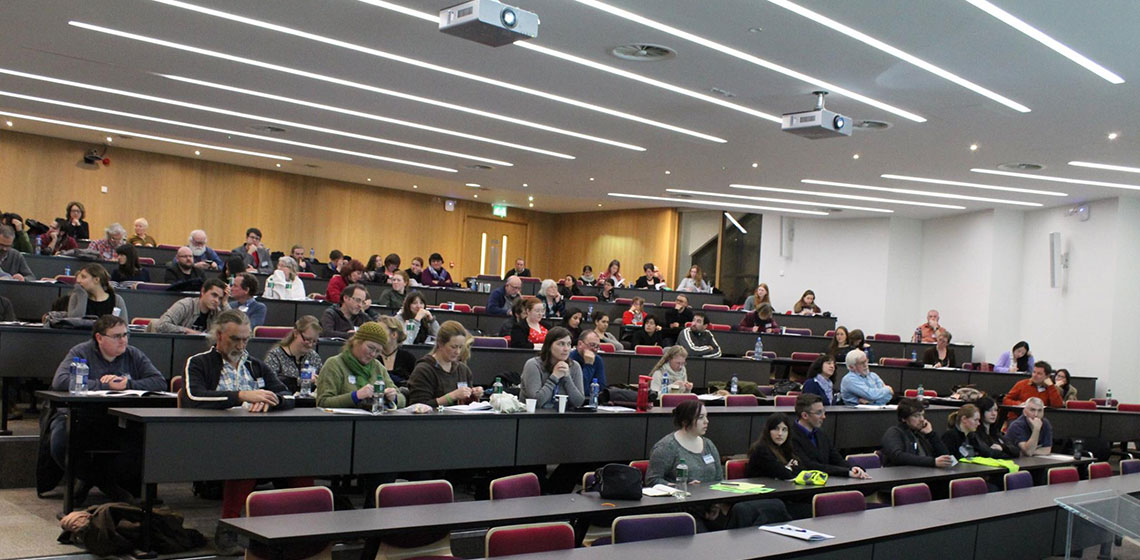
The ninth Experimental Archaeology Conference was held over 16-18 January 2015 at University College Dublin (Ireland). A large gathering of nearly 200 delegates from more than 25 countries across the EU and the Americas was hosted by UCD School of Archaeology and the Irish National Heritage Park. Twenty papers and 26 posters were presented, while Professor William Schindler gave the keynote address.
Each year this conference is eagerly anticipated by its participants and their enthusiasm was reflected on social media leading up to 16 January. Some delegates arrived in Dublin early for EXARC’s shoulder programme on 15 January. Others kept in touch via Twitter as they travelled, sharing their excitement – and information about the challenging weather conditions that affected flights into Dublin.
Welcoming everyone to the comfortable and well-appointed O’Brien Science Centre, Professor Aiden O’Sullivan introduced the first day and first session, (Re)constructing Houses and Buildings. Four papers were followed by four poster presentations in an innovative format used throughout the conference.
This structure was very well received by the audience. During each session, twenty-minute papers gave their authors time to go into each topic in depth, whilst the three minutes allowed per poster presentation gave a platform for each author to relate their research findings. Together, each session’s set of papers and posters comprised an interesting mix of synthesis, new research, experience and ideas.
For example, Dave Freeman shared long-term experience of building constructions on site at Butser Ancient Farm (Hampshire, UK) in his paper presentation Understanding Iron Age construction techniques through the reconstruction of ‘Great’ roundhouses; whilst Paul Grigsby from the Ancient Technology Centre (Dorset, UK) presented a poster, The Demands Of The Neolithic Houses At Durrington Walls: Time, Resources And Landscape, about the natural resources needed to build Neolithic houses at Durrington Walls (Wiltshire, UK) according to calculations from a unique construction project for English Heritage.
Session two, entitled Daily Life, Practice and Food Technologies, included presentations from the UK, Italy, Norway and USA. This session was typical of the Experimental Archaeology conference’s strength in accepting and promoting work from individuals at varied career stages, including undergraduate, post-graduate, independent, self-employed and established professional researchers.
Communicating, Knowledge and Learningbegan after lunch with some of the fantastic footage of the Sea Stallion from Glendalough, a reconstruction of Skuldelev 2, a Viking longship built in Dublin around 1042 with oak from Glendalough Co. Wicklow, sailing the high seas from Denmark to Ireland in 2008. All of this session’s presentations were about projects that used mixed learning techniques – but especially kinaesthetic learning – to teach and share information. This was the perfect introduction to the conference keynote address by Professor William Schindler from Washington College (USA).
Soul Authorship: experimental archaeology, and the value of authentic learning experiences in Higher Education pedagogy was an inspirational address which chimed with every delegate. Schindler introduced his belief that when students take responsibility to author a project from start to finish, then their learning will be deeper, richer, longer-lasting and relevant to their whole lives. He made the case that experimental archaeology offers such authentic learning experiences, summarised for me in the line, “How can you teach students about human evolution, if they have never experienced a real fire?”
Demonstrations as varied as prehistoric musical instruments and research into warp-weighted looms followed, with drinks and supper after, before a number of delegates made their way from UCD campus into the city. Dublin was a great place to socialise; its fine Georgian architecture set off by the bright winter sun and welcoming pubs and bars offering warming places to relax in the evenings.
Day two began with Session five, Forged in the Fire: Aspects of Hot Technologies. Pyrotechnologies are very popular topics and this session introduced some really interesting new findings; including Giovanna Fregni’s latest work on prehistoric copper alloys that promises many new lines of enquiry.
Building on these more technological papers, Session six Thinking Through Methods and Approaches and Session seven, Innovation and Technological Approaches introduced innovative uses of new investigative techniques. 3D scanning, photogrammetry, and even 3D printing featured heavily. However, it’s fair to say that everyone was also very happy to spend time exploring UCD School of Archaeology’s outdoor area dedicated to archaeological experiments, getting some hands-on experience the old-fashioned way. We explored construction experiments, watched demonstrations of bronze castings, iron smithing and tinkering, and warmed ourselves by a bonfire kiln being used to fire pots.
Everyone was deeply impressed with both the organisation and the content of these two days. On Sunday 18 January, two coach-loads of delegates visited the Irish National Heritage Park, Ferrycarraig (County Wexford, Ireland). The traditional hospitality was outstanding, with tea and scones on arrival, a hot lunch and finally drinks before the day was out.
The Park itself is a fascinating site, with constructions and activities communicating aspects of the past from the Mesolithic to the “Age of Invasion” with Viking lakeside houses and boatsheds, and medieval structures including a chapel. These constructions, and their uses in demonstrations, prompted vibrant discussions between the visiting delegates – if only we had had more time…
We thank the combined EXARC and UCD School of Archaeology teams who gave us EAC9, a hugely informative and enjoyable three days of exciting and inspiring experimental archaeology.